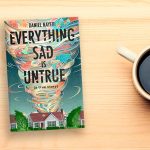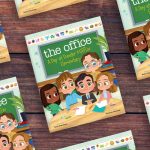“Mind off. Body On.” This was the simple guidance offered by my favorite gym instructor before any of her classes began. It didn’t matter what she was teaching—kickboxing, yoga, strength training—her instruction held the same power each time. I was suddenly in the flow!
Anyone who has tried meditation knows that it is rarely that simple to turn the mind off. We begin filling up these vessels of knowledge from the moment we enter the world. Words are assigned to every single thing around us, even the human beings who first love us. So, it is no wonder that our words are constantly forming and falling apart, creating endless scripts and waves of stories that our curious (and sometimes tired) minds must sort through, analyze, compartmentalize, and remember. As educators we pass along these words as building blocks, as vital pieces of information, as histories and explanations.
If you’re already exhausted by this glimpse of our busy, chattering brains, imagine how our young sponges must feel. Our students are new to the world, still trying to figure it all out. And we fill their brains constantly with what we’ve determined is important for them to know. Now, obviously education is important. If we did not believe this, we would not be in the business. But we also know there are multiple ways to learn and to teach. Trying various approaches that match our strengths and interests is key to transferring a world of knowledge in a way that is enjoyable for the educator and meaningful for young minds.
During my years as a public and school librarian, music and movement became constant companions to the stories I shared in my library programs. These elements enriched the experience for us all and seemed to deepen students’ understanding in ways beyond measure. Multiple times over the years, I’ve had readers run up to me on the playground, at the library, or sometimes out in public. They would snap their arms like an alligator or show off a few salsa steps or maybe tap out a drumbeat on their body and say: “Miss Xele! Remember that story you told us about….?” And then they would recall the exact details or message of a particular book I’d shared years before!
This marriage of muscle memory and narrative recollection amazed me! It’s one thing to read studies on the benefits of gross motor activity, music, and how they relate to literacy and learning, but it’s quite another to see the results unfold before you over time, especially in such joyous ways. The more confident I became experimenting in my library laboratory, the more passionate I became about infusing components of music, movement, and mindfulness in as many programs as possible.
My transition into the role of visiting author felt fluid. I had just returned home to the United States after two years of serving as head librarian at an international school in China. Our first book with Cinco Puntos Press, All Around Us, was recently released and was receiving quite a bit of praise. So, as I was unpacking my actual bags from a life abroad, I began packing my figurative bag with all the best “tricks” I’d learned in librarianship.
While in China, I had deepened my practice of tai chi or qigong—a method of moving and connecting with the energy that flows within and around our bodies. I excitedly told my students (who ranged from pre-K to middle school) about my new book and asked if they would be the first to tryout my idea of “tai chi storytelling.” I had witnessed and practiced “yoga storytime,” but figured this twist would be appreciated in that region and valued as a learning experience back home.
Two years and over 60 author visits later, I can say with certainty that this “tai chi storytelling” program has been the most well received across ages and cities. Of course, students benefit from writing workshops, art demos, and the ever-entertaining Q&A sessions. But there is something magical that happens when they begin to breathe and move their bodies in unison, portraying parts of a story that was once mine but is now a part of them.
The energy in the room really does shift, from something frenetic (picture pre-COVID days when 300 students would be crammed into a cafeteria or gym to “meet the author”) into a mood that is quiet, observant, pensive, and yet full of life and surprise. Because our young ones are so much closer to the source of our true nature, they tend to reach this place of peace and flow with relative ease. But I have also lost count of the number of adults who have approached me after a session with gratitude for feeling alive in their bodies after many years of having lost touch with their essence.
With a second book on the horizon, I feel a renewed commitment to bring my story to life with music, movement, and mindfulness. Where Wonder Grows is similar to my first book in that it celebrates a child’s connection to their ancestors and to the earth. It takes place in Grandma’s garden, where the children share their favorite finds from nature, exploring the elements that helped create relics like rocks, meteorites, crystals, and shells.
You’ll be the first to know the trick I have up my sleeve for this author visit: With the help of a multi-talented musician friend, we will be dancing the elements! Feeling fire, flowing with water, jumping through air, and connecting with earth. And not to worry; we won’t be doing this in your classroom, gym, or library…at least not anytime soon. While our kiddos are staying safe at home, we can do our best to get them moving in meaningful ways.
Like many authors, I have shared free programs online in an effort to support the work of parents and educators during this unusual time. My “tai chi storytelling” program is already featured through Cinco Puntos Press and the San Antonio Public Library. Our “dancing the elements” program will be released in early 2021, along with my new book, Where Wonder Grows.
Now more than ever, it feels vital to experiment with radical ways of thinking, learning, expressing, and inhabiting knowledge. I encourage you to share the tools that have worked well for me and to sharpen the tools and tricks you have within. When we tap into our own strengths and lifelong passions, we connect with something primal—even ancestral—that enhances the human experience. At this point, some of you may be thinking that you don’t have much to share beyond your lesson plans. To that, I will return to the lessons of my wellness coach: When the mind doubts, trust that the body knows.






